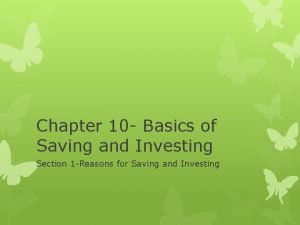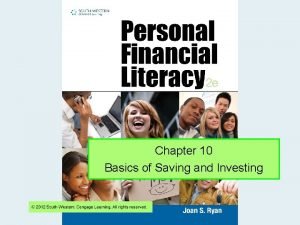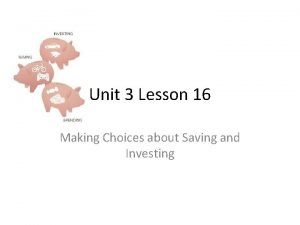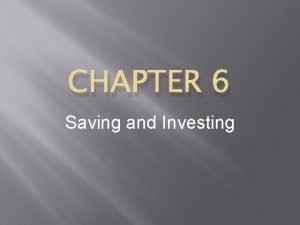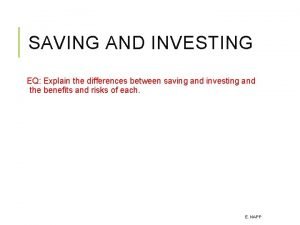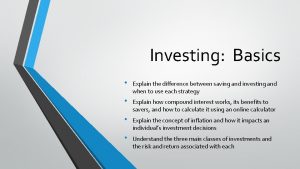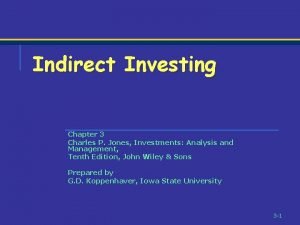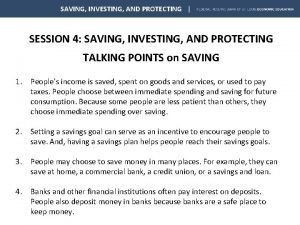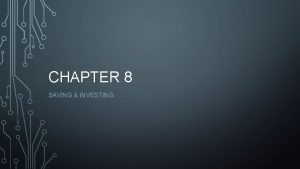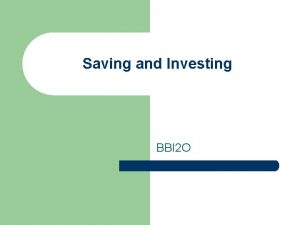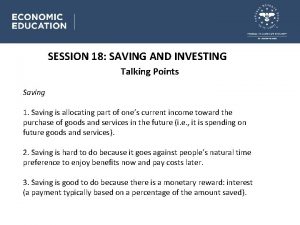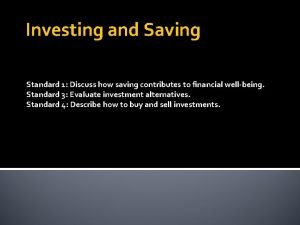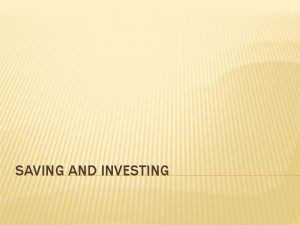Saving and Investing Investing and Free Enterprise Investing










- Slides: 10

Saving and Investing

Investing and Free Enterprise • Investing money is a way to increase your money by either not using it today (savings), or by using it to create more money (stocks, bonds, business ownership, property, etc…) • This invested money is used to build new business, and encourage economic growth.

Financial Intermediaries • There are many kinds of businesses that link savers and borrowers • Risk can be reduced by diversifying (having more than one type) investments • Banks, Savings and Loans, Credit Unions • Finance Companies • Mutual Funds • Life Insurance Companies • Pension Funds

Risk in Investing • Typically, the higher the payout, the riskier the investment. These risks can be described in different ways – Credit risk (The borrower can fail or bankrupt) – Liquidity risk (Cash tied up in non-cash investments) – Inflation rate risk (Interest rates change, lowering return) – Time risk (Your money might be unavailable for a while)

Financial Assets • Bonds: (I. O. U. ) Many kinds of bonds, including Federal, corporate, municipal, and others. • Certificates of Deposit (CDs) • Money Market Mutual Funds (Trading financial assets like bonds, with a group of investors) • 401 Ks, IRAs, T-Bills, Stocks

Stocks • Stocks are investments that show partial ownership in a company

• Stocks come in two main varieties: – Common Stock can vote, lower priority – Preferred Stock cannot vote, higher priority • Profit can be made by collecting dividends or by selling the stock (capital gains) • As stocks increase in value, they may split • Stock prices are determined by supply and demand, and therefore are not necessarily representative of the value of the company – this can cause “bubbles” like the technology bubble at the end of the 1990 s

• Stocks are traded at stock exchanges around the world, or online – American – New York – Tokyo - Nasdaq - Hong Kong - London • Many stocks are included in Indexes. These Indexes are used to determine the health of the market – – Dow Jones Industrial Average (DJIA) Standards and Poor’s 500 (S&P 500) Russell’s 3000 Nikkei Index

DJIA 1928 to present

Bull and Bear Markets • Bull and Bear markets describe general conditions in the market • A Bull Market is going up • A Bear Market is going down
 Lesson twelve saving and investing
Lesson twelve saving and investing Chapter 10 basics of saving and investing
Chapter 10 basics of saving and investing Chapter 10 basics of saving and investing
Chapter 10 basics of saving and investing Unit 3 lesson 2 saving and investing
Unit 3 lesson 2 saving and investing Chapter 6 saving and investing
Chapter 6 saving and investing Explain the investment poem concerning stocks and bonds.
Explain the investment poem concerning stocks and bonds. Saving vs investing venn diagram answers
Saving vs investing venn diagram answers Direct investing vs indirect investing
Direct investing vs indirect investing Putting the enterprise into the enterprise system
Putting the enterprise into the enterprise system Enterprise
Enterprise Topic 2 free enterprise and other economic systems
Topic 2 free enterprise and other economic systems

